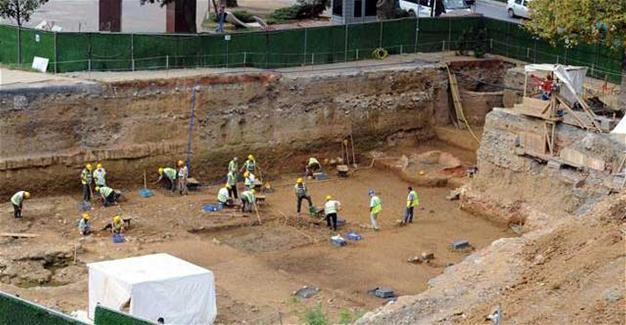Subway construction excavations fill gap in Istanbul’s history
Ömer Erbil - ISTANBUL
 Ruins believed to be dating back to 6,000 years from the Neolithic age have been unearthed during a subway line construction in Istanbul’s Beşiktaş district.
Ruins believed to be dating back to 6,000 years from the Neolithic age have been unearthed during a subway line construction in Istanbul’s Beşiktaş district. Carried out by the Istanbul Archeology Museums, the excavations reveal buried slices of life in Istanbul, a first in the strait, according to officials.
The 19th and 20th century ruins were unearthed during the construction of the Kabataş-Beşiktaş-Mecidiyeköy-Mahmutbey subway line. The Cultural and Natural Heritage Preservation Board said the findings did not need to be protected in their original place and ordered for their removal after scientific drawings and recordings were finished. Following the removal of the ruins, excavations have continued under the inspection of the museum.
The excavations are expected to provide brand new information to shed light on the history of Istanbul, especially the Bosphorus Strait, which cuts through the city and divides it into two continents.
Circular Neolithic age structures like the ones in the Yenikapı archaeological excavations and urn-type tombs have been unearthed around these structures.
The findings initiated excitement among archeologists as it is the first time such discoveries were being made in the Istanbul strait. Just like on the banks of the Bayrampaşa Stream in Yenikapı, there was a Neolithic age settlement around the Ihlamur Stream in Beşiktaş. Officials believe the finds will fill the historical gap between 6500 and 3000s B.C. in Istanbul.
The finds suggest more crucial discoveries are waiting to be unveiled when the works go deeper. Historical data obtained during the Yenikapı and Üsküdar subway station excavations will be richened with the ones in Beşiktaş.
From 4,000 BC
Turkey’s leading Neolithic age expert, Professor Mehmet Özdoğan, visited the excavation field to examine the findings, confirming that they were from the Neolithic age. He said the director of the Istanbul Archaeology Museums, Zeynep Kızıltan, was behind the great success.
Stating that such findings were covered in the past, the professor said, “After the findings in Yenikapı, there was a big gap in Istanbul’s history. There was a period that we did not know of. Now we will fill this gap with the discoveries in Beşiktaş. I am extremely excited. It is a tremendous discovery since it is in Beşiktaş, the center of Istanbul. The circular structures are typical Thrace settlement. We see it until the Iron Age. I think they are from 4,000 B.C. It will become definite as more finds emerge.”
Historic discovery in the Bosphorus
“The fact that traces of pre-historic settlement have not been found so far in the Bosphorus, which is an important waterway connecting the Black Sea basin and Aegean-Mediterranean world, increases the importance of Beşiktaş excavations. The findings unearthed in Yenikapı, Fikirtepe, Pendik, Yarımburgaz and Ağaçlı in the past showed us that Istanbul has extraordinary historical values. The circular structures found in this Beşiktaş subway construction are interesting findings that should be handled. As for the other circular structures in the Marmara region, the ones in the Neolithic-age village in Aktopraklık Mound in Bursa-Ulubat Lake and Akçalar field are interesting. Now the gap between Mesolithic and the Bronze age can be filled,” archaeologist Nezih Başgelen said.
















